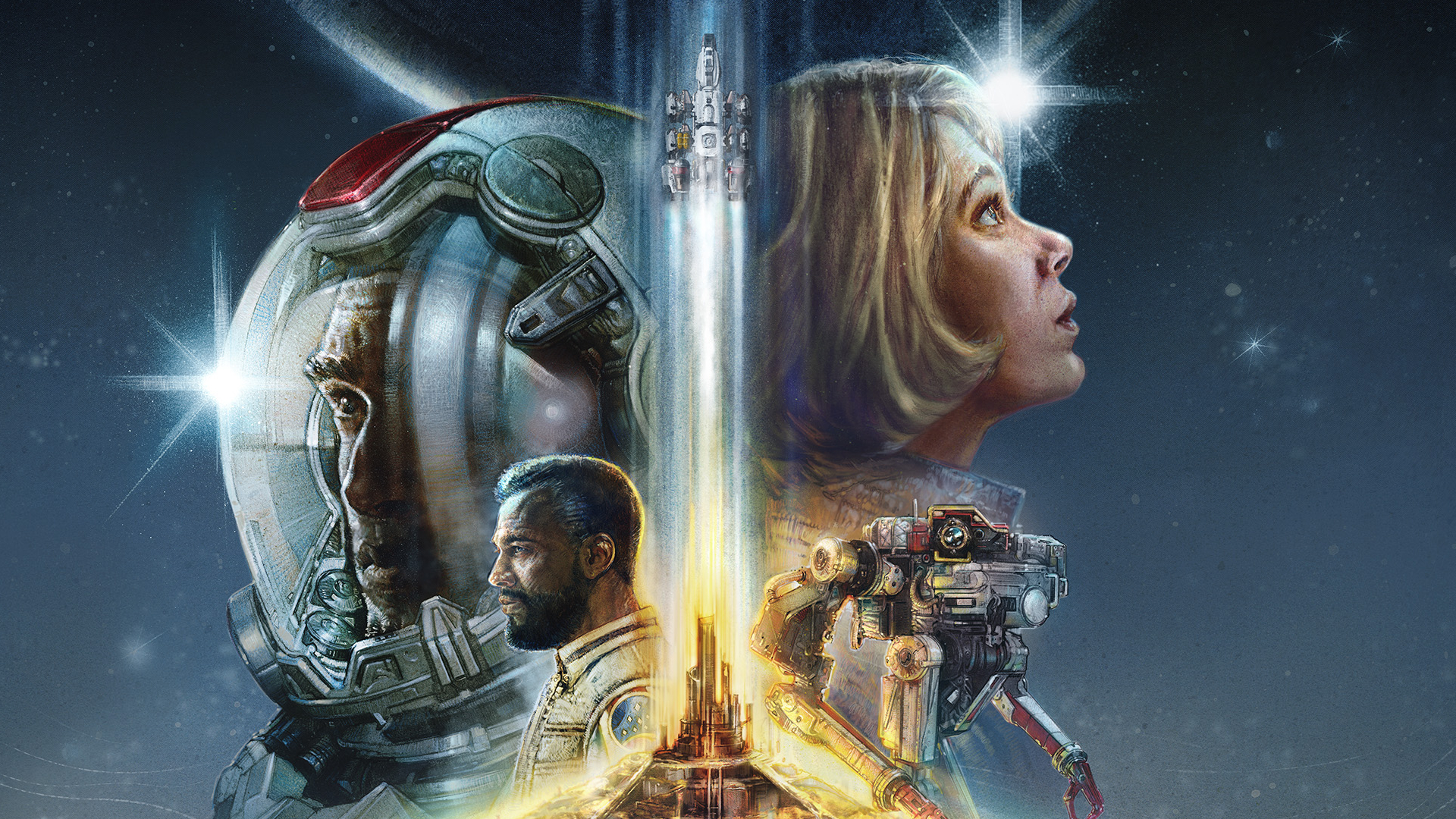Starfield mods - lessons Bethesda must learn from Skyrim's modding scene
I used to be a modder like you. Then I took an Anniversary Edition to the .exe

Whenever the next big Bethesda Game Studios title comes around, we have double the reason to board the Hype locomotive all the way to Impossibly High Expectation Central. Because not only do we get a vast RPG that’s rich in environments, lore, NPC stories and incidental details, we also get a modding platform to bend and twist the aforementioned RPG into whatever demented vision we can imagine. (If you’ve forgotten what I mean, allow me to jog your memory.)
Todd Howard has confirmed that Starfield will have full mod support well ahead of launch, which means all of the above holds true for BGS’ upcoming game - it’ll probably be absolutely brilliant, and then it’ll probably spawn an absolutely brilliant modding scene that’ll give us years of strange, beautiful, and inevitably, weirdly sexualised experiences.
But there’s also reason for caution. Because for all the incredible additions it spawned, goodness gracious, Skyrim has been an absolute nightmare for content creators and mod users alike. It was never supposed to live this long. It was never supposed to run on our smart toasters. And as a result of that unnatural lifespan brought about through constant re-releases, Skyrim has inadvertently made vast, vast swathes of UGC incompatible and redundant several times over.
Here, then, are the lessons both we and Bethesda must absolutely learn from Skyrim in order to ensure a better platform for Starfield.
1. No ‘special’ editions that create mod incompatibilities

I think most of us know what I’m referring to here. Bethesda released a Special Edition of Skyrim in 2016, five years after its original launch. The intention was to upgrade the visual fidelity of the game for users on PS4, Xbox One, and PC. Ooh look! Volumetric lighting! Slightly better snow! That looks cool.
But there was a significant maggot in the sweetroll - Skyrim: Special Edition looked better than five-year-old original Skyrim, certainly. But modded original Skyrim made Skyrim: SE look like Ape Escape.
It got worse. Skyrim modding is a precarious house of cards. It’s propped up with SKSE, a script extender that allows for a multitude of features beyond the scope of the vanilla release. Most mods that modify NPC behaviour, spells or combat use SKSE in some form. So if SKSE stops being able to talk to the Skyrim .exe, it’s bad news.
Get daily insight, inspiration and deals in your inbox
Sign up for breaking news, reviews, opinion, top tech deals, and more.
So when Skyrim: SE arrived in late 2016 and resolutely didn’t work with SKSE, it meant that a very significant swathe of the modding content that users had been building up for half a decade was now incompatible with the latest version of the game. Not an issue for console players who hadn’t been faffing about with these kind of mods in the first place and were instead bound by workshop/store content, but for PC players at the time it felt like a disaster.
The community adapted, though. Modders found a way to convert their original mods to SE, and although it took a lot of work at first, by 2017 it was pretty straightforward to do. And by that time most modders had made the jump over to SE in order to make use of its new visual effects.
And then Bethesda did the exact same thing all over again.
Except this time, when Skyrim: Anniversary Edition released in 2021, 10 years after the original launched, it worked like an update to Skyrim SE on Steam instead of a separate SKU. In other words, unless you had auto updates turned off, this new version of the game installed itself over your fastidiously modded Skyrim SE install and rendered all your mods useless again.
Again the fist-shaking. Again the mass update project. Those poor people who develop SKSE.
The lesson’s very simple: PC players and console players are not to be treated as one homogenous consumer blob. We have very different needs, particularly when it comes to how our games are updated and how new editions are delivered.
Starfield is likely to be a stratospherically popular game. Popular enough to warrant Special Editions and remasters down the line, just like it’s dragon-thwacking ancestor. Bethesda can and will drop new content for it. But it needs to deliver it with the needs of PC players at the front of its mind. Don’t do this to us again Bethesda, please. I’ve only just got the enormous anime jiggling boob physics working again.
2. Don’t release DLC that a mod already does better

Nothing against Skyrim’s Hearthfire mod, but just like the above point, it only really met a need among console players. Over on PC, we’d been lording it about in preposterous 50-room mansions with armour display cabinets and jacuzzis since not long after launch. Heck, we’d been downloading player home mods as far back as 2006, for Oblivion. The last thing we needed in a paid expansion pack was the ability to build one single player home.
In Starfield, it’ll likely be spaceships and the customisable elements within them where modders place their focus. Right now at this proximity to launch that feels like a really important part of the game. You’re flying around a thousand different planets, a brain-melting amount of real estate, and your ship is likely to provide one of the only constants in the game, one of a few precious elements that make this all feel like one connected adventure. Your adventure.
So it’s going to be a natural point of emphasis for modders. Now if a paid expansion releases post-launch that adds in some ships, or ship customisation elements that pale in comparison to the volume and quality the modding community has already generated up to that point, it’ll be a bad look and another clear lesson from Skyrim ignored.
3. Use the modding scene as a gauge for what players actually want in expansions and DLC

An extension of the above point, and an opportunity for Bethesda to better attune to its community: look at what modders are actually making, and the content that’s proving most popular among players. Then use that data to guide the direction of post-launch content.
And no, that’s not a direct contradiction of point 2, I promise.
Here’s an example: in vanilla Skyrim, certain modding directions were nigh impossible. Deeper NPC interactions, smarter AI, better animations, more detailed physics. The community did devise solutions to most, if not all, these areas eventually, but they had to Heath Robinson their solutions, performing the code equivalent of slapping a bunch of electrical tape over the problem. Had Bethesda come forward and expanded the game’s creation tools in those areas themselves, we might have seen a very different Skyrim modding scene.
Starfield shows signs that it’s taken direct influence from Skyrim’s modders. Player companions have a much deeper system to them, it appears, than was the case in vanilla Skyrim. So when Starfield releases, Howard and co can really take the temperature of the community and expand the game’s modding functionality - rather than simply the content - in the directions that creators really need.
4. No paid mods, please

Remember paid mods in Skyrim? It was based around implementing a pay-what-you-want model to creator content on Steam Workshop, whereby the money was split between creators, Valve, and Bethesda. It didn’t work.
There are all kinds of reasons it didn’t work. Modding is incredibly collaborative and iterative. To get one single mod to work there’s a string of contingencies that you also need installed. Modders build on each others’ work. That’s just how it works. Often it happens simply by asking for permission or giving credit. But when money starts getting involved, that system doesn’t work as well, as Skyrim’s paid mods showed. Copyright disputes were raised, mods were pulled from the store, and players who’d paid for content were left without it.
Modders deserve compensation for their work, but there are existing crowdfunding channels that allow for that. Paywalling the content just doesn’t work, and in the case of Skyrim’s paid mods in 2015, it created a huge fan backlash and plenty of infighting between modders.
Starfield is on our radar of upcoming games worth keeping an eye on, but if you're looking for more titles to enjoy prior to its release, it's worth checking out our list of best RPGs, or our list of best free games if you're looking for something cheaper to pass the time.

Ad creative by day, wandering mystic of 90s gaming folklore by moonlight, freelance contributor Phil started writing about games during the late Byzantine Empire era. Since then he’s picked up bylines for The Guardian, Rolling Stone, IGN, USA Today, Eurogamer, PC Gamer, VG247, Edge, Gazetta Dello Sport, Computerbild, Rock Paper Shotgun, Official PlayStation Magazine, Official Xbox Magaine, CVG, Games Master, TrustedReviews, Green Man Gaming, and a few others but he doesn’t want to bore you with too many. Won a GMA once.